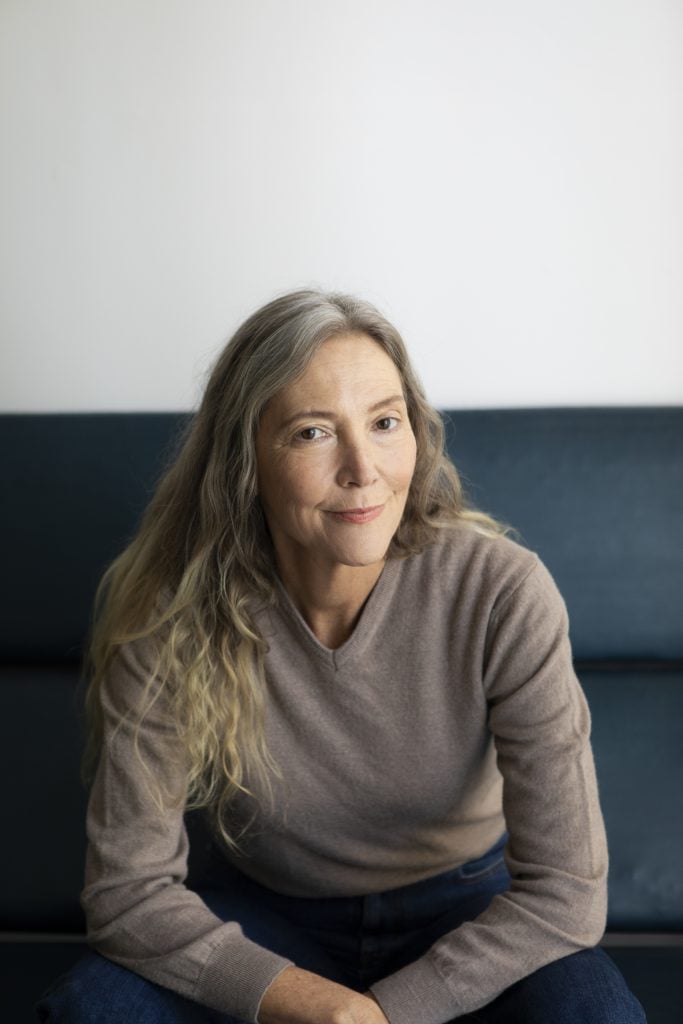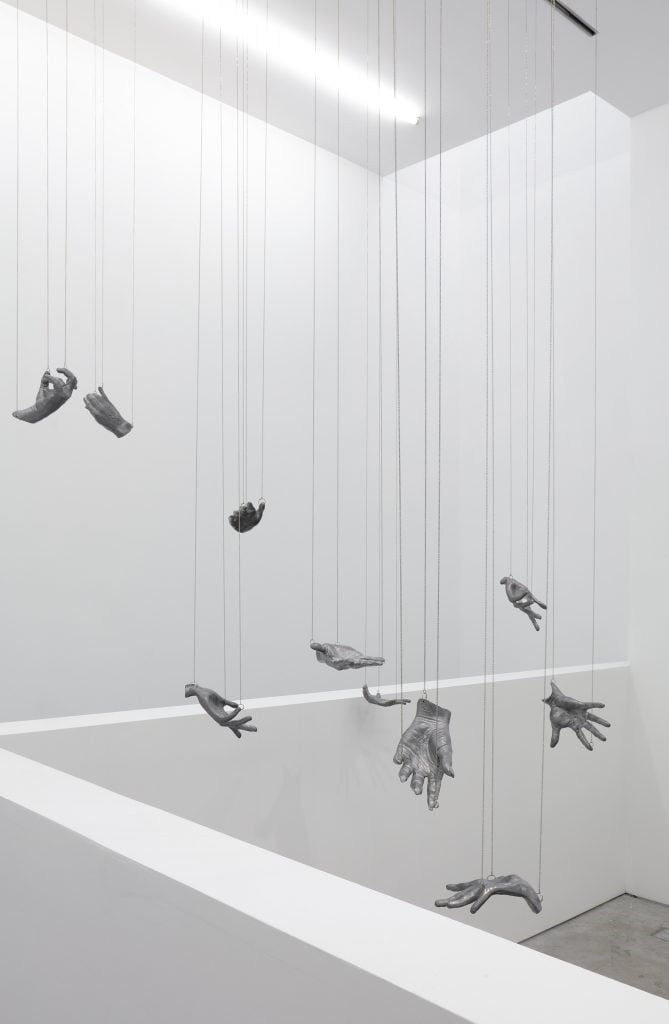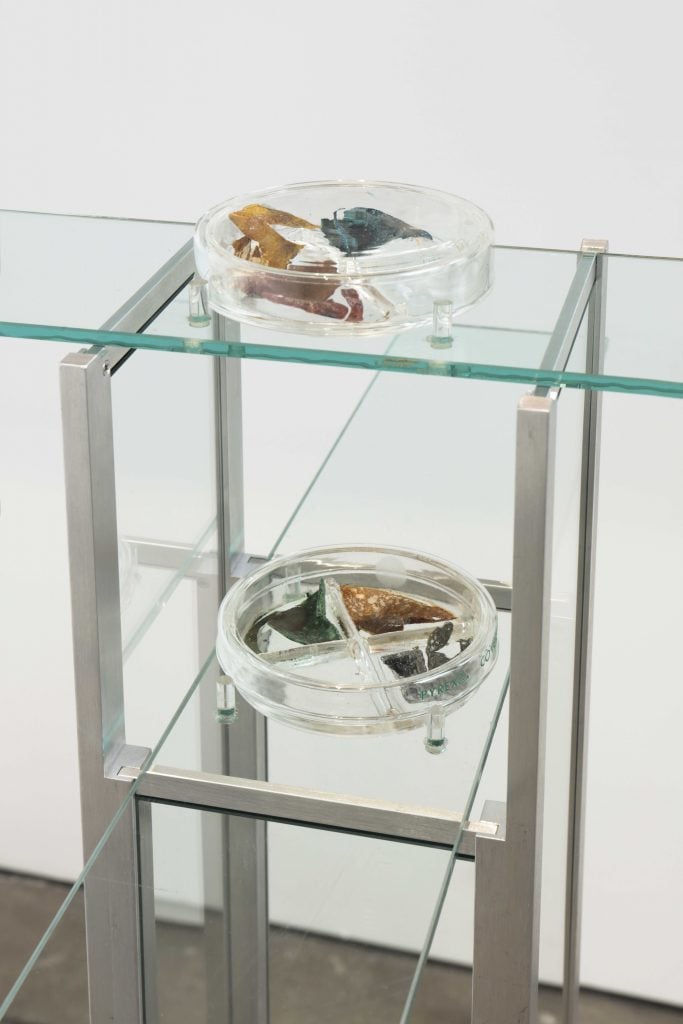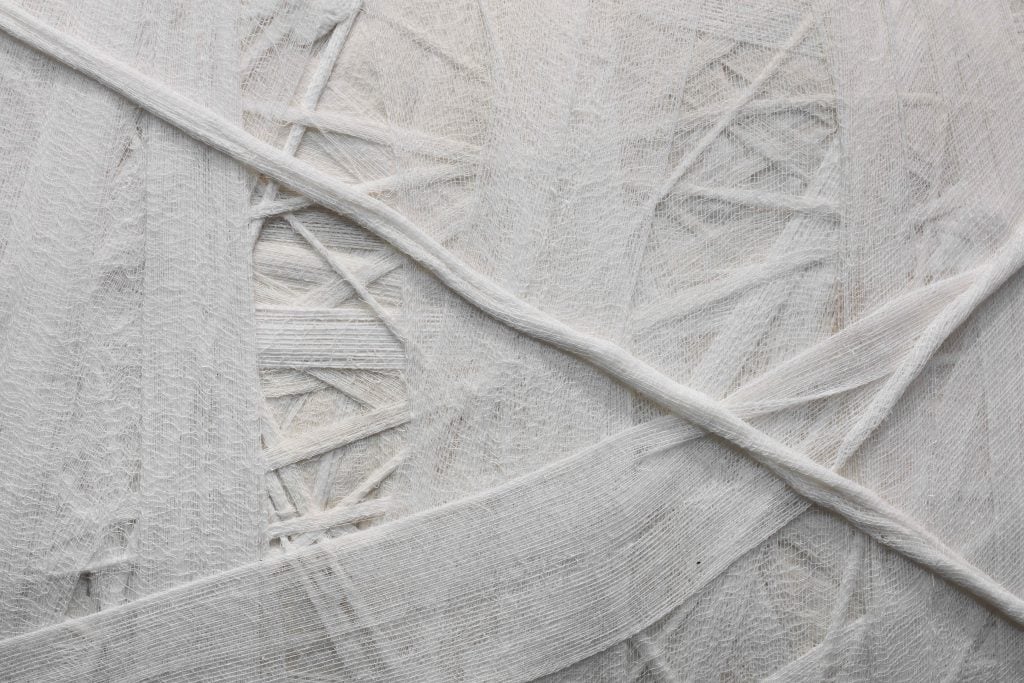People
Artist Liz Larner Has Spent 30 Years Making Sly Sculptures We Still Don’t Have Words For. But After Speaking to Her, We Found a Few
The artist's extraordinary 30-year retrospective is now on view in New York.

The artist's extraordinary 30-year retrospective is now on view in New York.

Pac Pobric

I don’t mean to start off like a sourpuss or anything, but doesn’t it sometimes feel like the art world’s a bit phony? Look, I get that “branding” is super important, but sometimes it just feels a bit… inauthentic? One of the things I love about Liz Larner is that she’s not interested in having a visual trademark. Her traveling 30-year retrospective, “Don’t Put It Back Like It Was,” now at the Sculpture Center in New York (through March 28; it goes to the Walker Art Center in Minneapolis on April 30), looks like a group show by a dozen master craftspeople.
And I do mean a dozen. Among the 28 works on view is one balled up from 16 miles of surgical gauze (Larner is deadly playful); a work called Corner Basher that swings an enormous metal ball repeatedly into adjoining walls (I didn’t say she couldn’t be aggressive); and a 10-foot leather mat covered in thousands of false eyelashes made of human hair (she’s also a fastidious maker).
Add to this a suite of wall-hanging ceramic works full of accidents only a kiln could imagine (she always leaves room for chance), an elegant and imposing Fred Sandback-like installation made of nylon and silk—titled after a work by Brancusi, it suggests part of her art-historical lineage—and a sand-filled group of leather bulbs titled No M, No D, Only S & B (1990), which reveals her adeptness with wordplay. (In her exemplary catalogue essay on Larner’s work, art historian Connie Butler writes that the sculpture “proposes an alternative family with no parents, only sisters and brothers.”)
Artnet News spoke with Larner—who, with her straightforward and unguarded demeanor has to be one of the least phony people in the art world—about her many approaches to art-making, her childhood on the Sacramento River, and why photographs do injustice to sculpture.

Liz Larner’s No M, No D, Only S & B from 1990. The work, art historian Connie Butler writes, suggests a family with only siblings, and no parents.
Liz, I don’t think we know your work all that well in New York, but you’ve had seven solo exhibitions at Regen Projects in L.A., you show with Max Hetzler in Europe, and you’ve been making work for 30 years. I want to congratulate you on the show. It’s really impressive. One thing that struck me is that it could almost be a group show. You have all these very different kinds of things. How do you avoid falling into old patterns?
I have said that kind of jokingly, about the group show. But there are patterns, though they don’t always play out the same way. I would rather have an idea that gets put into different guises, and see what happens. I usually work in shows: I’m doing a show, and it’s about something, and then I move on to the next. But this kind of thing, where you’re taking stuff from 30 years ago and putting it together—it’s really a credit to [the show’s organizers, Walker Art Center director] Mary Ceruti and [Sculpture Center deputy director] Kyle Dancewicz. It was so gratifying to see their interpretation.
Do you remember Hands (1993), near the stairwell? When I made that, people were just so dismayed, because it was going in a direction they didn’t think I was going. It was disappointing to them; it threw them. People thought I was a post-Minimalist or something, but I never thought of myself as a post-Minimalist. I was working with forms and colors before, and it was abstract, but abstraction and figuration have never been areas that couldn’t blend. I wanted to do both. I wanted to include all of it.

When Liz Larner first showed Hands (1993), it threw off her audiences. “People thought I was a post-Minimalist or something,” she said. “But I never thought of myself as a post-Minimalist.” Photo courtesy of the artist and Regen Projects, Los Angeles. © Liz Larner. Photo: Cathy Carver.
And maybe there was a conceptual aspect to it. I was going to [show at] Sonsbeek [in the Netherlands], and they had me come over to Holland to look at some sites. I was at the Gemeentemuseum. There were two statues across this courtyard from each other, and both had their hands knocked off. It just made me think: it’s such a classic necessity in sculpture, to do the hand. And I thought people could follow along. When I first showed it, it was in Paris and the show was called “Possibilities of the Existence of Meaning, Without Words, Inside Disorder.” Then I showed it again in New York, and the show was just titled “Without Words.” It was about a gesture. There are only 10 hands in that group, but depending on how they’re presented, they read very differently.
You use a lot of wordplay in your titles.
I love language, and I’m in awe of great writers. I don’t know how they can do it. The most I can put together is a title [laughs].
But they’re very evocative titles.
Well, thank you, I am proud of my titles. They really help me to add another element, and I play around with it a lot. The “Cultures” are titled after what they’re cultured from. So Orchid Butter Penny (1987)—that’s from before, when I was just putting stuff in petri dishes. But I got an inoculating wand eventually, and I went to the Twin Towers and took cultures from the front doors, and to the Empire State Building and took an inoculation from the roof. That’s what’s in Primary, Secondary: Culture of Empire State Building and Twin Towers (1988).

Several works in the show include microbial cultures, including this one from 1988, which includes inoculations taken from the Twin Towers and the Empire State Building in New York.
It seems important that you live and work in L.A. Have you ever read anything by Mike Davis? I’m reading Ecology of Fear, I’ll just read you the blurb on the back. “The classic book on L.A. as a locus of ecological destruction—in culture and in reality.” What’s so fascinating about Davis is that he’s good not only with social and political history, but also ecological processes and facts. It does seem like you Californians are forced to confront the natural world more so than we do in New York.
I don’t know Mike Davis’s history, but I was born at the end of 1960. I grew up on a farm in the Sutter Basin, about 60 miles northwest of Sacramento. I grew up next to the Sacramento River. There were crop dusters that sprayed DDT on the field next to our house until I was seven. My encounter with nature and culture was impressive, even as a young kid. And then when I moved to Los Angeles—Los Angeles has changed so much [over the years], but it’s very wild. I’ve seen a family of raccoons running across the street and diving into the gutter. There are animals all over the place. I’m also super interested in Joan Didion. That’s someone who had a huge influence on me. It really tears down the mythos of California, which is this makeup on top of a corpse.

A detail from Out of Touch (1987), one of the earliest works in the show. The sculpture is balled up from 16 miles of surgical gauze. © Liz Larner. Photo: Cathy Carver.
Since we’re talking about the environment, one of the questions I sent you before we spoke has to do with the fact that in the past, you’ve said that the built environment is the world of men, and you’re not interested in repeating those forms. Would you call your works feminist forms?
Okay, so I had to write this down. I’m just going to read it: “New forms look like things that we don’t recognize, that there aren’t yet words for. They are invisible to most of us. I try to see them but probably miss a lot of them, even though they’re all around. Maybe new forms aren’t made by humans. Maybe we only copy them when we see them. I’m not sure of this. I guess they emerge and someone says, ‘Look,’ and then they have to change.”
And then I have, “I think that some things that are currently being called assemblages can be considered feminist forms. Something that is together, but flexible and unfixed; linked, but free moving; mixed in a knot in a way that is together and emergent. Something that can accommodate its own indeterminacy. Something capable of adaptation.”
Let me ask you some specific forms. I know you’re really interested in corners. What’s important or interesting about corners?
You know what I just found out? My husband—he does music—and I are actually moving out of California. So we’re building a studio, and he’s been figuring out how he wants to make it. And one thing that’s fascinating and new to me about corners is that sound gets trapped in them.
I did not know that.
Yeah. And corners are places where things intersect, and start and end. Do you know the artist Eric Wesley? He’s a California artist. He’s going to be in the Whitney Biennial this year. He spoke on a panel last week at Sculpture Center about my work, and he brought up Corner Basher and said something that was really astute. He said, “Though that’s the name, it is not the action of the machine.” And that’s really true. The machine cannot quite get to the corner. I’ve made a number of works that address the corner, and none of them do the same thing. It’s a place to keep thinking about.
I should mention that with Corner Basher—I’ve never, not once, not for a second in my life, been afraid at a museum. And I was legitimately afraid! It’s not only extremely aggressive, it’s also remarkably unstable because it’s on wheels. And it spins really fast!
It could go on even higher. I turned it down because when I first got it, it really did get too unstable. I first showed it in L.A., but when I showed it in New York at 303 Gallery, it didn’t have attachments [holding it] to the wall. It was in a corner and the on/off switch was right by the elevator. This woman came in, turned it on, and turned it all the way up. But because it wasn’t chained to the wall, it started moving towards her. And they had to come out and save her, or it would have been bad. What I like is when you turn it off, it has this weird tetherball balance. It’s just—it’s so overly dramatic, that piece.
One final question on photography, because you have a photography background. How has it contributed to your work as a sculptor? Most artworks today are consumed through images. Is there anything you try to do to account for that?
You know, I honestly believe that sculpture cannot be photographed. It cannot really be conveyed. And that’s what I love. That’s what I wanted to deal with. That’s why I think people are happy with my show: there’s this other side to the thing, about walking around the show and being embodied, and really sensing the material. That’s not available on screens. It gives you a different kind of knowledge.
Your work really does seem to resist the culture of the image. Before I saw the show, I had just seen pictures of your work, and I didn’t understand anything until I saw it in person.
I take that as a compliment. To me that’s like, I’m doing my job.